Text by Fiona Glen
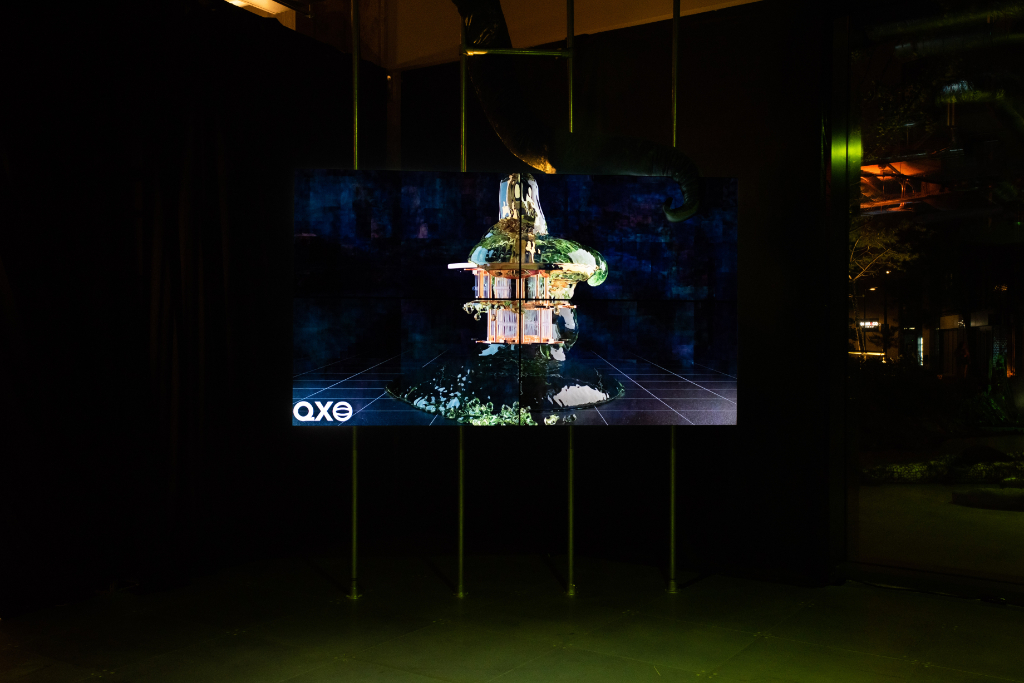
A cluster of white geometric pillars that resembles a technological acropolis or the idealised spaceship interiors in 20th-century sci-fi – sterile but emanating a near-sacred glow. This digital reconstruction of a real design for an IBM quantum computing facility is punctuated by the bold italic font that blurts PROBE / THE / FUTURE as if a highly commanding oracle manifests in animated typography. The image is shattered by amphibian eggs, snails, and leaking purple skies. Forms twitch and glitch with tendrils, veins and white noise, and then a veil of glossy slime flows, glistening over a quantum computer’s coiled bronze cooling tubes.
OPTIMISE
NOW
Seated in the arms of a giant octopus cushion, I am watching the QX product launch video for immersive experiences (2022), one of the video works that frames artist and quantum information science PhD Libby Heaney’s show – The Evolution of Ent-: QX at arebyte (London) – within a fictional company: Quantum eXperience, or QX. Heaney harvested language from promotional materials surrounding real quantum computing ventures and inserted them into QX ads and brand videos.
These reimagine Heaney’s 360-degree immersive installation Ent- – which she built in Unreal Engine using quantum data – as QX’s own ‘world-first’ product. Until the 20th of August, entering arebyte is effectively entering the company’s lobby, where animations on digital panels – Heaney’s QX extended advertisements (2022) – thrust hyperbolic phrases at you: REALISING THE FULL PROMISE OF QUANTUM. REACH YOUR FULL POTENTIAL.
Formerly a copywriter for an experience agency, I was trained to distil complex ideas and offers into the shortest, simplest, shoutiest phrases – especially when the subject was technologically innovative. The brand of QX is immediately recognisable. It is the self-replicating voice of the attention economy. Hyperactive, hype-commanding, high on the promised technologies of a Future, which is inevitably better because it is shiny, fast and full of information. Sense total possibility. Unleash the limitless. Accelerate your capability. Imperative verb + expansive promise. Do it, have it, grasp it, own it, all this intangible stuff, you want it all. If you can, you better take it and make it work for you. Because if you don’t, someone else will. No questions asked.
The brand language might seem like a symptom, but it’s part of the machine. Marketing fuels the translation of possibility into product. This way of speaking is a way of thinking is a way of exploiting. The message is more compelling if you don’t take the responsibility of going into details. The trick is to be forceful and vague at the same time. OPTIMISE NOW. But whom is optimising, and for what?
Quantum particles operate according to different laws from our macroscopic world – which makes them impossible to visualise. Among their tricks are being able to be in multiple places simultaneously, acting in tandem with other distant particles from a great distance, and taking on the properties of both particles and waves. The bits inside quantum computers do not speak in a language of zeroes and ones but in a dance of movements, waveforms and positions in relation to one another. Heaney tells me that her quantum code sometimes resembles a musical score.
Working outside of a binary, quantum computers can test many possibilities simultaneously – and extremely quickly. This means they could massively accelerate vital medical research, be deployed to solve complex ecological and social problems, and redistribute resources in radically more efficient ways. But they could also circumvent or unpick most of our current data security measures: carrying out rapid unindexed searches, reassembling anonymised data into profiles, decoding encrypted communications, and undoing blockchains and cryptocurrencies as we know them today.
The implications for quantum computing to accelerate surveillance capitalism are huge. Libby Heaney mentions that a recent paper examined how the technology could be used to scan human brains for specific information: I made a speculative work about this, and now it’s being researched. In QX product launch video, the subtle mention that the experience ‘combines art and analytics’ hints that Ent- is not a one-way display; QX could harvest valuable data from the bodies of people within it.
In many ways, Heaney’s world of QX is all too ‘real’ in its critique of data extraction, market forces converting attention into profit in ever-more intimate ways, and commercialised states of ‘immersion’. We are familiar with the relentless categorisation, extraction and reselling of our lives in the form of information; commercial interests ooze into ever-more intimate spheres of our lives like the various embodiments of slime that erupt into every work in The Evolution of Ent-: QX.
Several years away from functional deployment, quantum computing is still a scientific frontier – but its future applications could represent a paradigm shift in the information systems that inform our daily lives. We are in a precious window of opportunity for broad and critical engagement with its evolution. If this unruly, invisible realm is going to reshape our societies, everyone should have a say in how. We can’t let our futures keep getting sold off before we have a chance to imagine them.
Art and speculative storytelling are some of the most impactful and accessible ways to take technologies and their impacts out of their specialist fields, making space for open-ended responses. There are widespread perceptions of what AI ‘looks like’, for example, but no dominant public narrative about quantum computing yet, says Heaney. I want to provoke a destabilised bodily response that allows people to feel the realm of quantum. This is a really important moment to engage people with it.
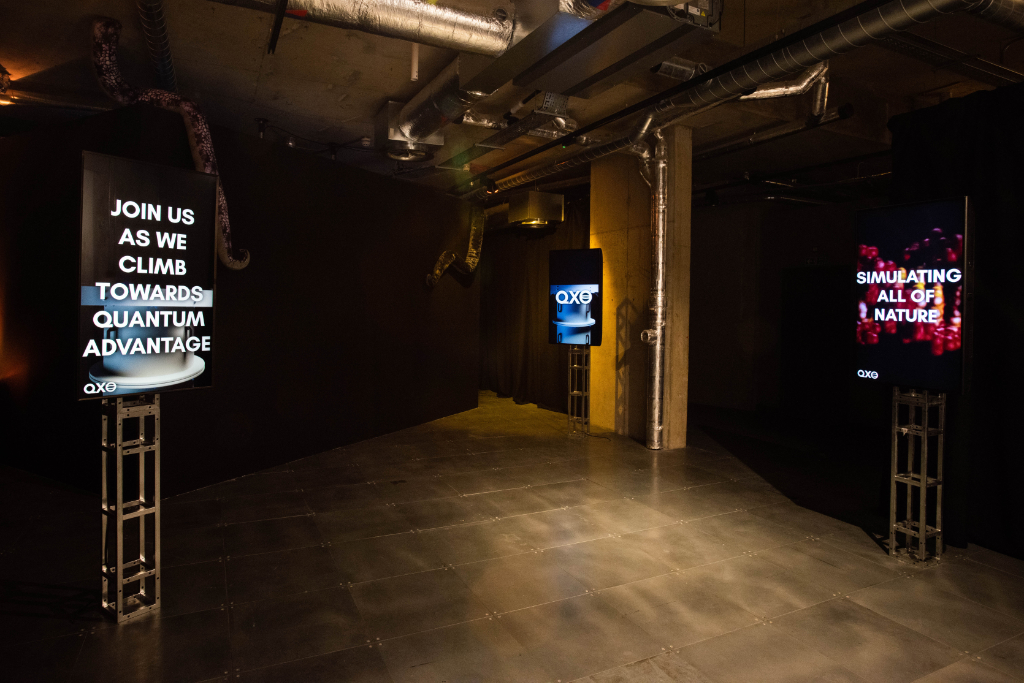
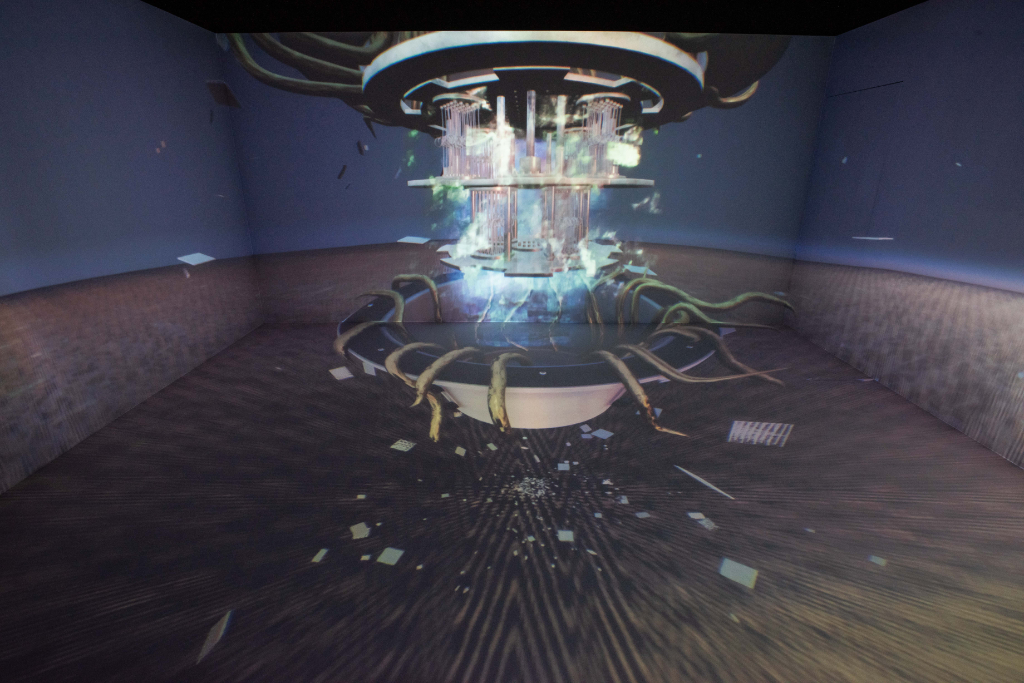
This opportunity was missed (more actively than we assume) in the development of the internet, machine learning and social media networks. In a 2021 interview, Faye Wattleton – co-founder of quantum computing company EeroQ – describes how people concerned with the privacy and political implications of the internet’s evolution were ignored, considered a minority of marginal naysayers standing in the way of advancement. Now, tech companies are beset by scandals and public distrust, scrabbling to retroactively solve problems like bias, data profiling, and disinformation. Developers often have their heads buried in their projects, but when their new technologies are unleashed on the world without measures in place to prepare society for their impacts, we all live through the consequences.
I ask Heaney whether – in her past life as a post-doc quantum information researcher – she found that scientists and developers usually considered it ‘someone else’s job’ to consider ethics. It’s worse than that – there’s a real disinterest or lack of thought about in ethics from the vast majority. Scientists tend to believe they’re only trying to crack problems or ‘discover the nature of reality’ as if it’s inevitable or neutral. This scientific positivism has collided with a big tech ethos which has no qualms about accelerating surveillance capitalism, so long as it’s profitable.
For quantum computing to integrate ethics into its foundations – as advocates for broad consensus-building on a post-quantum, like Whattleton, argue it should – there first needs to be a huge expansion in awareness of quantum technologies and their possible impacts. Despite its worldmaking potential, quantum is an extremely expensive field with a tiny research community. Only a handful of companies have access to quantum computers. This is my background, so I still have all those connections, says Heaney, but there’s almost no access for artists into quantum, even though they would do the most interesting things with it – using quantum information to diffract realities. To be honest, I don’t think companies are interested in that critical voice.
In a world where new technologies need to be commercially viable to be realised, they repeatedly get shaped towards generating profit, driving unsustainable consumption. In her QX extended advertisements, Heaney highlights how quantum tech is already being positioned to find new ways to transport natural gas across the world. Grafted onto the status quo, quantum would simply rapidly accelerate environmental degradation rather than applying its power to solving complex problems – like the profound systems change we urgently need to slow climate breakdown.
A subtly ecological undercurrent runs through The Evolution of Ent-: QX, from the opaque and unsettling claim that QX is ‘simulating nature from the top down and the bottom up’ to the earthly bodies and environments that are metabolised into otherworldly visuals of Ent-. A quantum reimagining of a Hieronymus Bosch painting, the projection is a fusion of futuristic and historic, biological and technological imagery, contrasting with how big tech companies present their sleek, shiny, sealed visions of what ‘our quantum future’ looks like. In the belly of Ent-, a whispering, aqueous soundscape by Nabihah Iqbal surrounds me.
Chimaera-like amalgams of tentacles, barbs and insect abdomens refract and dissolve into coloured particles that swirl like a murmuration of starlings before reassembling into new forms. Tangled threads like mycelium pulse in an underground pool, and assemblages of rotating forms collapse, decay, and reanimate. Standing in the space, I feel a sort of vertigo as shimmering wheatfields rush beneath my feet. Ent– has an animist quality; every entity is alive, interrelated, and metamorphosing into others.
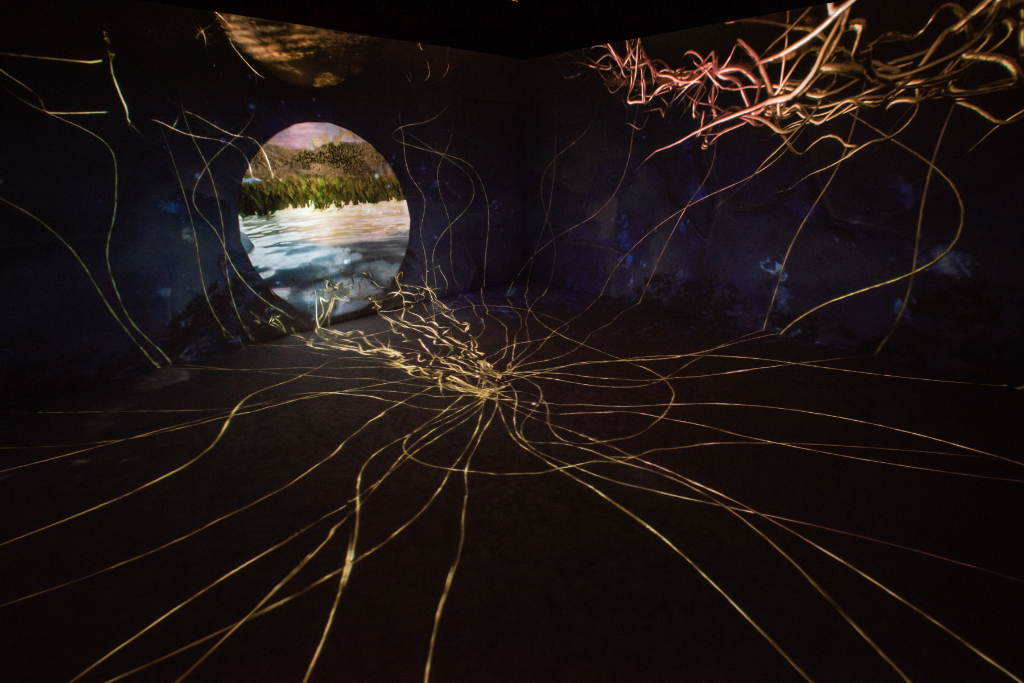
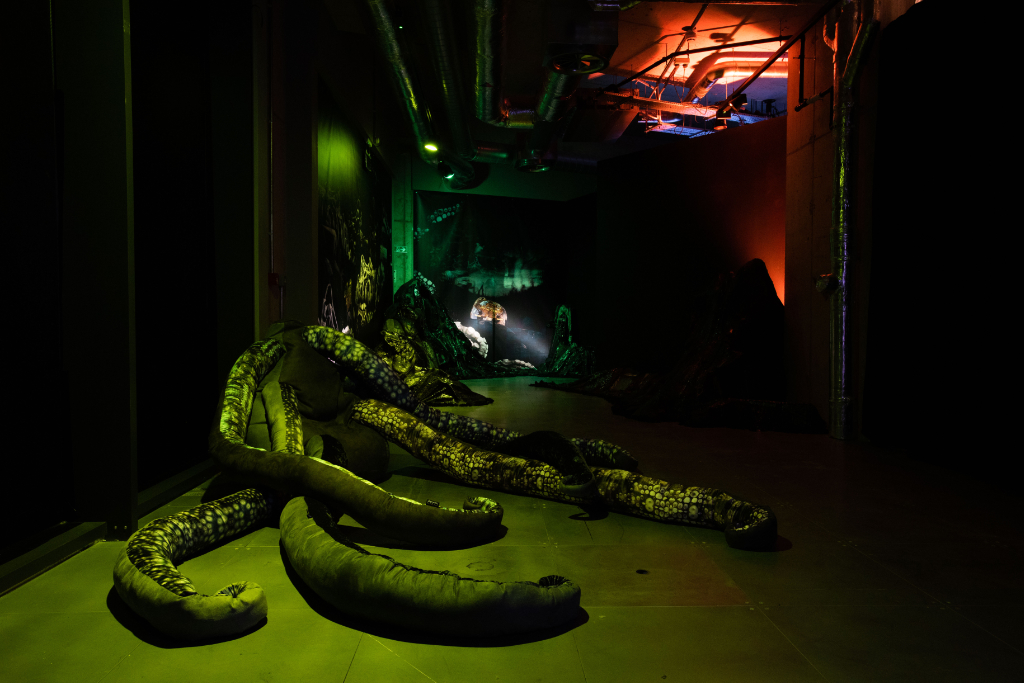
Here, I see what Heaney means about allowing people to ‘feel’ quantum: rather than desperately trying to depict a microscopic reality that cannot be visualised on a macro level, Ent- translates quantum entanglement and duality into an experimental, unfixed story. And beyond expressing quantum entanglement, this feels like a representation of entangled material existence, which all ‘artificial’ things still originate from and are constantly embroiled in.
I ask Libby whether quantum entanglement can help us to understand our complex interconnection with things that are also too impossibly big to visualise – like climate change. Absolutely, quantum knowledge can help us understand our relations with things far beyond our perceptions.
In Heaney’s entangled thinking, feminist physicist Karen Barad’s concept of intra-action is vital. The term replaces the exchange of interaction – in which individuals are assumed to be bounded – with a more complex sense of agency, where relationships emerge from ‘within’ intra-acting entities, rather than only what happens between them. But the idea of quantum entanglement operating on an imperceptible scale yet surrounding and pervading us reminds me of Timothy Morton’s definition of climate change as a hyperobject: something so massively distributed that its totality exceeds human understanding, even while we are still intimately enmeshed with it.
Morton’s hyperobjects stick to us; they are ‘viscous’, clinging to, changing, and being changed by everything and everyone with which they come into contact. Global forces like capitalism and climate change creep, sliding into every available space, like the slime that flows up from Heaney’s Ent- and its accompanying brand materials. I don’t only work with quantum, I also try to embody quantum in my practice – so, I don’t let meanings settle or become fixed. For me, quantum particles are slime-like, but I’m also thinking about the ‘slimy’ behaviour of big tech companies, she says.
Back in the (plush, furry, but still symbolically slick) arms of the giant cephalopod cushion, in front of the glitching launch video for Ent-, I watch black gunk cascade over the white faux-IBM facilities. It could be the uprising of uncontainable quantum matter, underestimated by the corporation; it could be a nauseating wave of commercialisation, covering everything with its sheen; it could be a typification of the unknowable and uncontained, a dark ecological-material force rising up beneath perception.
The mucoid waves flowing amongst a canned voiceover bring me back to the ever-slippery nature of marketing: a world that has appropriated the impactful language and methods of activism – a legacy present in terms like slogan and campaign. And, as I leave, hovering among the overladen promises and claims of QX, I imagine how the urgency of sales-speak could be replaced with urgent transformation. What calls to action do we need for a future where quantum information can help us flow towards more generative realities?
SENSE YOUR ENTANGLEMENT
QUANTUM FOR PLANET AND PEOPLE
INTRA-ACTION, NOT EXTRACTION
MULTIPLICITY NOW
ARTISTS FOR SLIMY JUSTICE
OPTIMISE FOR EARTH






